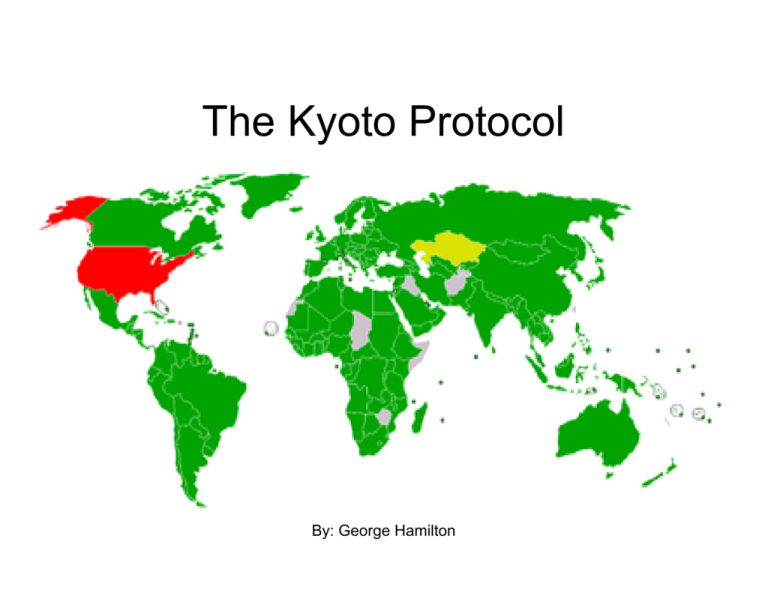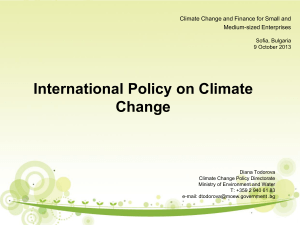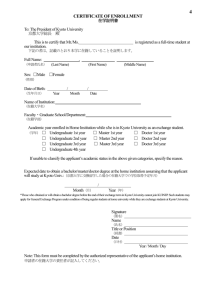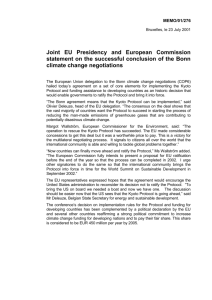The US and the Kyoto Protocol
advertisement

The Kyoto Protocol By: George Hamilton What is the Kyoto Protocol? • • • • • • It’s a United Nations-sponsored agreement among nations to reduce their greenhouse gas emissions by the year 2012. The Kyoto Protocol was finalized in 1997 after years of negotiations and the addition of binding targets for greenhouse gas reductions. The Protocol is aimed at developed countries, with no binding targets for industrializing countries like China and India, and required ratification of enough countries to represent 55% of the developed world’s CO2 emissions. With the US having signed and not ratified the Protocol, it took until 2004 and Russia’s ratification to bring the treaty into force. By the time the Kyoto Protocol had been brought into force, more than halfway through the allotted time for reduction, most countries’ greenhouse gas emissions had risen substantially. Many industrializing countries’ emissions were rapidly increasing as well. Few of the world’s developed countries are expected to meet their 2012 Kyoto targets. Notes for Slide 1 • I put the information in the bulleted points, rather than explaining them all in my notes section… • Sources: “The Rough Guide to Climate Change”, Robert Henson US Stance on the Kyoto Protocol •Despite the US being a Kyoto signatory, they have yet to ratify the Protocol due to many reasons. •In 1997, the Senate passed the Byrd-Hagel Resolution. This stated that the US would not sign the Kyoto Protocol if there were not binding targets for developed as well as developing countries and if it “would result in serious harm to the economy of the United States.” George Bush specifically pointed out China (now the world’s leading CO2 emitter) and India as countries with high CO2 emissions that shouldn’t be allowed exemptions. •Despite the US government stance on the Protocol, many US states and individual cities have brought about their own versions of Kyoto in an attempt to reduce GHG’s. Much of these efforts are thanks to Seattle Mayor Greg Nickels and his attempt at a nationwide effort to get cities to agree to the Protocol. It has been reported that Seattle hit its target reduction of 8% in 2005. Notes for Slide 2 • The graphs shown represent the leaders of total CO2 emissions, on the left, and leaders in CO2 emissions per capita, on the right. Although China has recently overtaken the US as the leader in total CO2 emissions, they still trail far behind the US in terms of emissions per capita. Bush bases his statements on the total CO2 emissions graph when arguing that China as well India should be subjected to the same binding reduction targets as the rest of the developed countries in the Kyoto Protocol. • Sources: “The Seattle Times: Seattle meets Kyoto global warming targets.”, “ByrdHagel Resolution”, “The Rough Guide to Climate Change” Support for the Kyoto Protocol • • • All countries of the world agree that reduction of greenhouse gases in the atmosphere is an important topic needing immediate reaction. Former President Bush acknowledged America’s need to reduce emissions, despite his reluctance to sign the Kyoto Protocol, by saying, “This is a challenge that requires 100% effort…my administration is committed to a leadership role on the issue of climate change.” Leaders of support for the Kyoto Protocol include the UN and the European Union as well as many environmental organizations in the US. Some of these groups within the US include The National Environmental Trust, the Union of Concerned Scientists, Energy Action and many more. Moreover, many individual cities and states within the US have promised to abide by Kyoto Protocol provisions. Supporters for the Kyoto Protocol often agree that this initial round of reductions may have little actual effect. Although, they remain hopeful that countries will remain committed to necessary preventative measures and that the initial round of reductions will lead to larger, more effective reductions in the near future. Notes for Slide 3 • Sources: “President Bush discusses Global Climate Change”, The Rough Guide to Climate Change, Ross McKitrick “Submission to the Joint Standing Committee on Treaties inquiry into the Kyoto Protocol.” Opposition to the Kyoto Protocol • • • • Despite the US being the only major country to have not ratified the Kyoto Protocol, there are pockets of opposition to the Kyoto Protocol’s provisions, effectiveness, and economic impact across the globe. Many people think the Kyoto Protocol reduction targets are unreasonable and will do little to effect the total amount of CO2 in the atmosphere. This sentiment is echoed by the Copenhagen Consensus project which found that the Protocol would have a superficial overall benefit. A report by the International Policy Network (IPN) claims that restricting GHG emissions in industrialized countries will actually hinder the growth in developing countries. This report can be seen as an attempt to persuade Europe to model their climate policy after that of the US. Some skeptics also believe that although humans have increased CO2 concentrations, the climate change will not be as disruptive as popular opinion states. These skeptics often believe that the warming will be too expensive to try to fix or reduce. Bjorn Lombourg estimates cost of global warming at 5 trillion dollars and argues that the effect of the Kyoto Protocol will be minimal. It will at least not create enough benefit justify the waste of money and global resources. Notes for Slide 4 • Sources: Bjorn Lumbourg, “the Skeptical Environmentalist”, CICERO www.cicero.uio.no/fulltext/index_e.aspx?id=3494, “The Impact of the Kyoto Protocol on US Economic Growth and Projected Surpluses”, The Rough Guide to Climate Change





